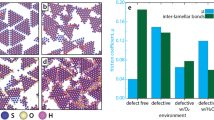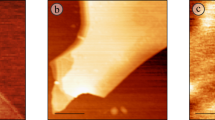Abstract
The motion of a nanoscale MoO3 crystal on an MoS2 substrate is an ideal case for the study of the effects of microstructure on macroscopic phenomena like friction, because both components of this system can be prepared with atomically flat surfaces. We apply a recently developed real-space density functional theory method to investigate the energetics of sliding an MoO3 crystal on an MoS2 substrate. We then link the results to simple models based on continuum elastic theory, in order to study the mechanical behavior of the oxide crystals under loads that correspond to realistic situations. Based on these results, we extract estimates of the force which must be applied with an atomic force microscope in order to move the oxide crystal on the substrate, for different orientations of the two components.
Similar content being viewed by others
References
Diestler, D.J., Rajasekaran, E. and Zeng, X.C., J. Phys. Chem., B101 (1997) 4992.
Cieplak, M., Smith, E.D. and Robbins, M.O., Science, 265 (1994) 1209.
Harrison, J.A., White, C.T., Colton, R.J. and Brenner, D.W., Phys. Rev., B46 (1992) 9700.
Hohenberg, P. and Kohn, W., Phys. Rev., 136 (1964) B864.
Kohn, W. and Sham, L.J., Phys. Rev., 140 (1965) A1133.
Modine, N.A., Zumbach, G. and Kaxiras, E., Phys. Rev., B55 (1997) 10289.
Zhong, W. and Tomànek, D., Phys. Rev. Lett., 64 (1990) 3054.
Perdew, J. and Zunger, A., Phys. Rev., B23 (1981) 5048.
Hamann, D.R., Schluter, M. and Chiang, C., Phys. Rev. Lett., 43 (1979) 1494.
Rappe, A.M., Rabe, K.M., Kaxiras, E. and Joannopoulos, J. D., Phys. Rev., B41 (1990) 1227.
Briggs, E.L., Sullivan, D.J. and Bernholc, J., Phys. Rev., B54 (1996) 14362.
King-Smith, R.D., Payne, M.C. and Lin, J.-S., Phys. Rev., B44 (1991) 13063.
Eschrig, H. and Bergert, I., Phys. Status Solidi, B90 (1978) 621.
Porezag, D., Frauenheim, T., Köhler, T., Seifert, G. and Kaschner, R., Phys. Rev., B51 (1995) 12947.
Sankey, O.F. and Niklewski, D.J., Phys. Rev., B40 (1989) 3979.
Sheehan, P.E. and Lieber, C.M., Science, 272 (1996) 1158.
Sheehan, P.E. and Lieber, C.M., Nanotechnology, 7 (1996) 236.
The question of determining in general which pairs of materials fit together well, and how precisely the materials will orient themselves relative to each other in the face of slight mismatches like in the MoO3/MoS2system is discussed in Hillier, A.C. and Ward, M.D., Phys. Rev., B54 (1996) 14037.
Landau, L.D. and Lifshitz, E.M., Theory of Elasticity, Pergamon Press, New York, NY, 1986. Here and in the subsequent analysis, we have set Poisson's ratio to zero.
Hues, S.M., Draper, C.F. and Cotton, R.J., Phys. Rev., B12 (1994) 2211.
Author information
Authors and Affiliations
Rights and permissions
About this article
Cite this article
Smith, G.S., Modine, N.A., Waghmare, U.V. et al. First-principles study of static nanoscale friction between MoO3 and MoS2. Journal of Computer-Aided Materials Design 5, 61–71 (1998). https://doi.org/10.1023/A:1008666530448
Issue Date:
DOI: https://doi.org/10.1023/A:1008666530448




